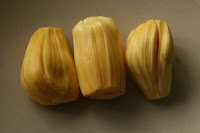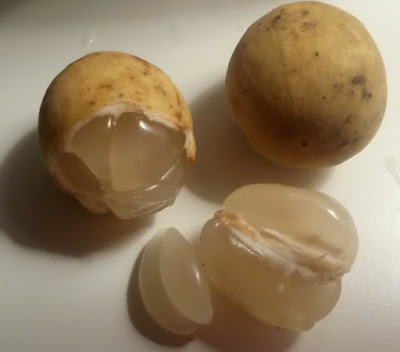| We continue our fruitopia (rather delayed with Christmas and all - happy new year!) by looking at a few more SE Asian fruits to taste and explore. | |
LonganOther names: mata kucing (Bahasa).Appearance: small, translucent white flesh, covering a hard brown seed. The tough outer skin is papery, and covers a thin white membrane. Both peel off easily, like separating a hard boiled egg from it's shell. Texture: soft and juicy FTW. | |
| Flavour and aroma: Very sweet, gentle tasting, like a kiss from the Easter bunny, filled with promises of warm sunshine and flowers. It tastes perfumed, similar to a lychee. Yummy rating: Grab a bag of these and chow down. | |
SapodillaOther names: ciku.Appearance: Like a kiwi fruit's gone bad, and turned brown (although a bit less hairy). Inside there are several very hard black seeds, approximately the size and shape of an olive pit, and golden brown flesh. | |
| Texture: Squishy, very soft and rather grainy, like a badly made custard. Scoop it out with a spoon. Flavour and aroma: Really sweet (like diabetes sweet), but the flavour itself isn't great - it's a bit reminiscent of a musty pear, like a pear you found in the back of your nan's cupboard in a forgotten fruit-bowl. Maybe the batch I bought are just a bit over-ripe? Or maybe they're always like this? The perils of trying something for the first time - you have no basis for comparison. Yummy rating: Not really. | |
Water appleOther names: jambu air (Bahasa), rose apple.Appearance: Like a bell pepper had sex with a cashew nut. Thin red skin, and a whitish inside (sometimes tinged a bit green or pink). There's a large seed in the middle. Texture: Crisp like a young cucumber, and very watery like a watermelon. | |
| Flavour and aroma: I'd had these once before, years ago, and remembered them as being a little boring (not much flavour, and only slightly sweet). But this batch are far worse than I remember. They're not sweet at all, and indeed have a slightly bitter under taste that becomes noticeable as you eat closer to the seed. I'd have guessed these were a vegetable, not a fruit, from the taste, and a not very nice vegetable at that. Yummy rating: Like cucumber but without the cucumber flavour. These would probably be edible in a salad, covered with a strongly-flavoured dressing (I'm thinking rojak), but as a fruit - nope! These really are not nice. | |


























